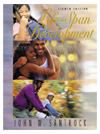 |  Life-Span Development, 8/e John W. Santrock,
University of Texas - Dallas
Beginnings Biological Beginnings
Chapter ObjectivesI.Discuss natural selection and the evolutionary perspective of human development. |
 |  |  | I.Understand the relationship between chromosomes, DNA, genes, and human reproduction cells. |
 |  |  | III.Distinguish between mitosis and meiosis. |
 |  |  | IV.Discuss the genetic principles of dominant-recessive genes, sex-linked genes, polygenic inheritance, genotype and phenotype, reaction range, and canalization. |
 |  |  | V.Discuss the goals of twin studies and adoption studies in behavior genetics, being sure to mention the difference between the two types of twins. |
 |  |  | VI.Discuss the disorders associated with abnormalities in genes and chromosomes. |
 |  |  | VII.Describe the method and purpose for tests such as amniocentesis, ultrasound sonography, chorionic villus sampling, and the maternal blood test. |
 |  |  | VIII.Describe the five most common techniques for helping infertile couples. |
 |  |  | IX.Present the common explanations for why outcomes for adopted children may be problematic. |
 |  |  | X.Discuss the controversy surrounding research on the heritability of intelligence. |
 |  |  | XI.Explain Sandra Scarr's views that genotypes drive experience and outline criticisms of Scarr's views. |
 |  |  | XII.Define and distinguish between passive, evocative, and active genotype-environment interactions. |
 |  |  | XIII.Distinguish shared environmental experiences from nonshared environmental experiences. |
 |  |  | XIV.Present some conclusions about the research on heredity-environment interaction. |
|



 2002 McGraw-Hill Higher Education
2002 McGraw-Hill Higher Education